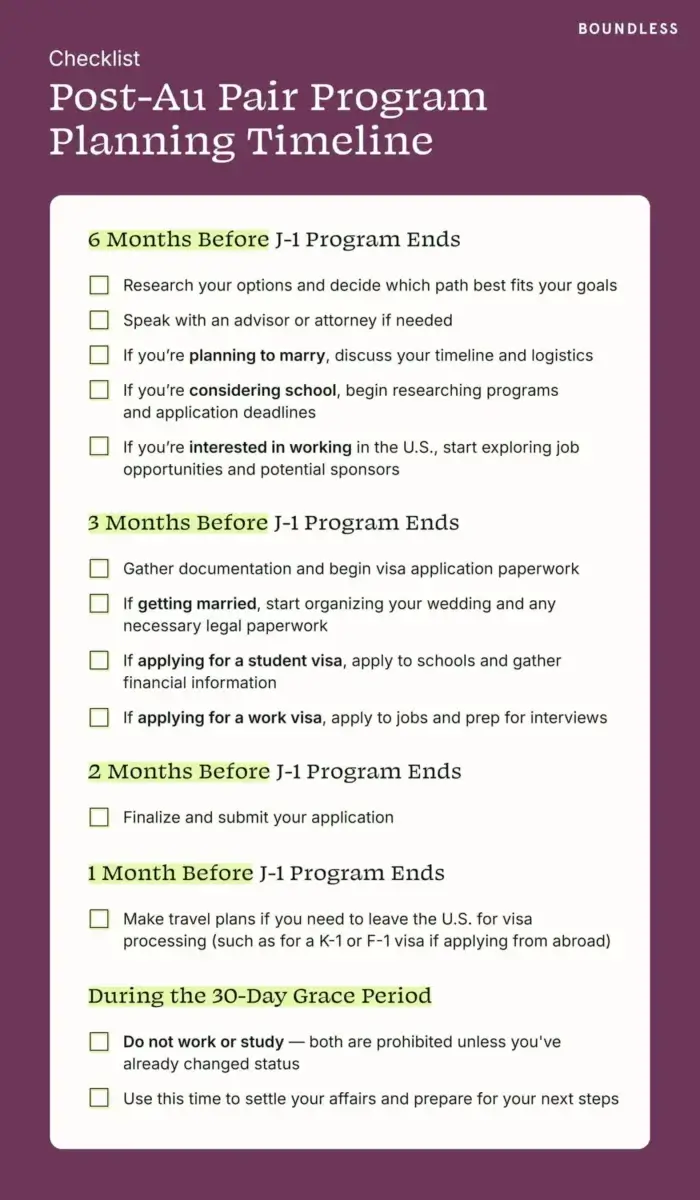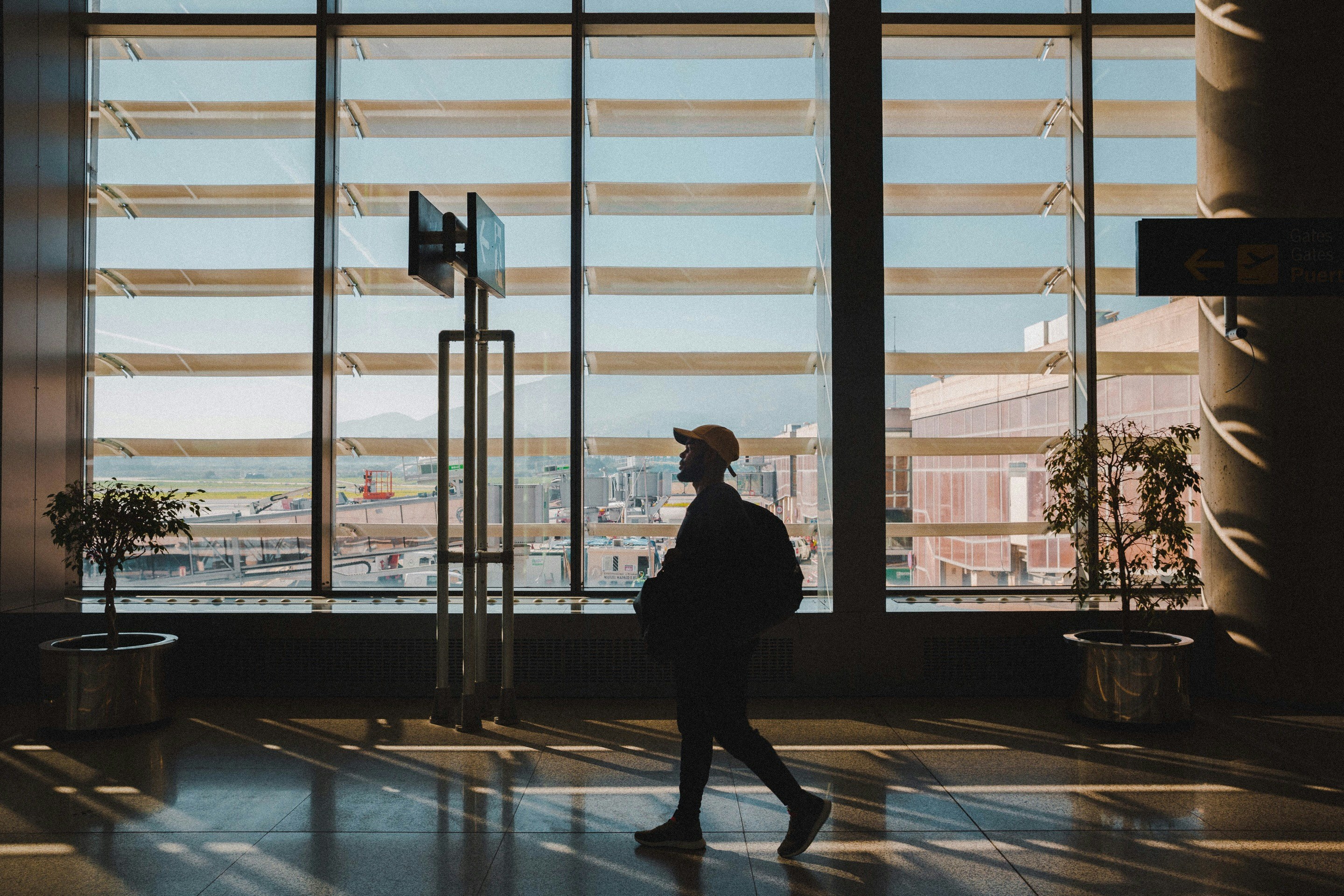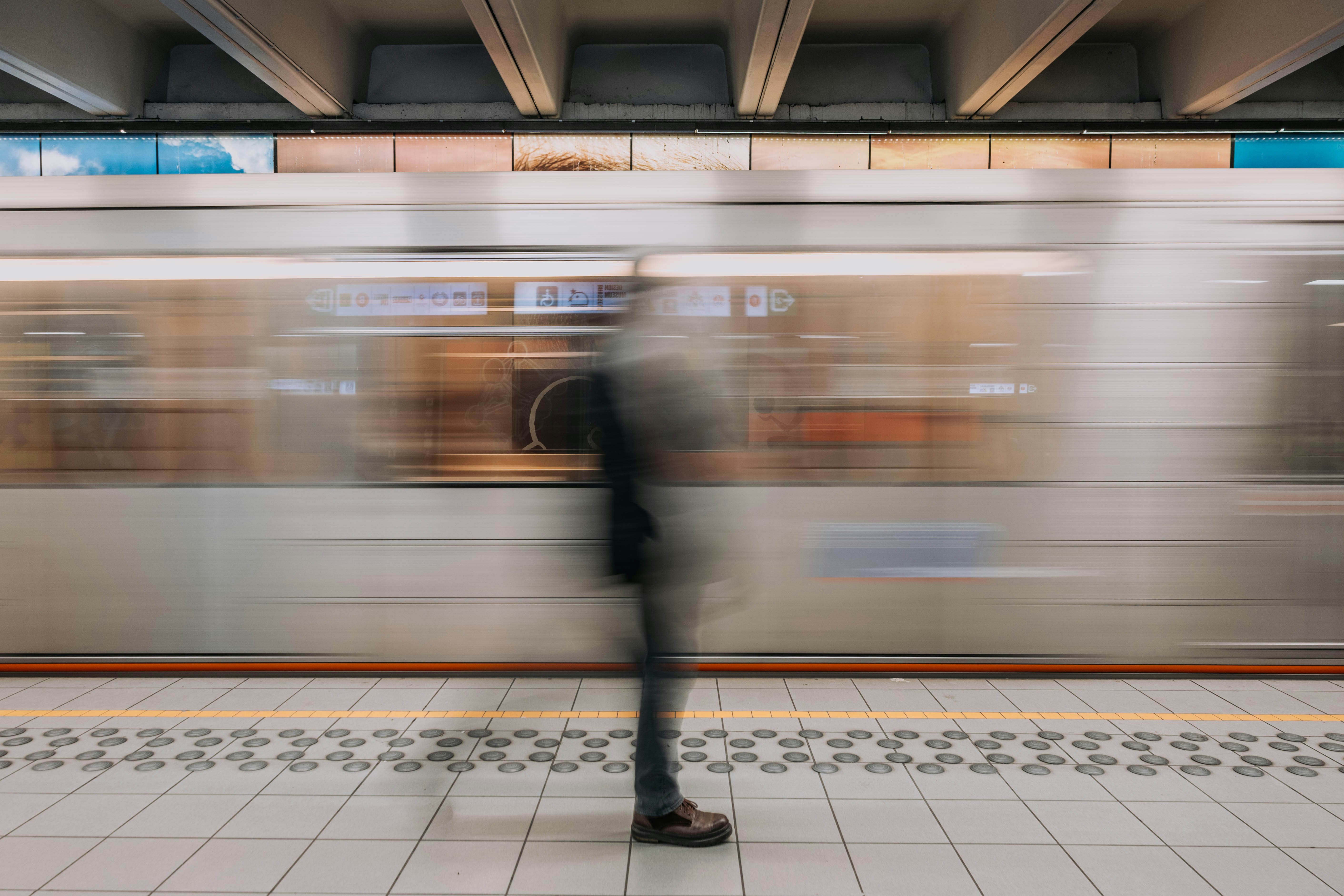How to Stay in the U.S. After Your Au Pair Program Ends

.svg)
Each year, thousands of young people come to the United States as au pairs on J-1 visas. But when the program ends, many aren’t ready to say goodbye. Whether you’ve built strong relationships, fallen in love, or want to pursue new opportunities, you’re not alone in wondering how to stay in the U.S. after your J-1 visa expires.
This guide explains what happens when your J-1 visa ends, the most common legal pathways to stay in the U.S., and how to avoid costly mistakes so you can make the best decision for your future.
Understanding Your J-1 Visa and Grace Period
The J-1 visa for au pairs is a temporary cultural exchange visa that typically lasts 12 months, with an optional 6, 9, or 12-month extension. Once your program ends, you are given a 30-day grace period to leave the U.S. During this time, you may settle your affairs and plan your departure.
During the grace period, you can:
- Stay in the U.S. for up to 30 days after your program’s end date, which is listed on your DS-2019 form
- Travel within the U.S.
- Return to your home country before the 30-day grace period concludes
During the grace period, you cannot:
- Re-enter the U.S. on your expired J-1 visa
- Legally work or attend a U.S. educational institution
- Change or adjust your status, unless you’ve already started the process before the 30-day grace period began
If you stay beyond the 30-day grace period and you didn’t apply to change status before your J-1 visa expired, you’ll fall out of legal status, which could lead to serious immigration consequences, including removal proceedings or a ban on reentry.
What to Do When Your J-1 Visa Nears Its Expiration
In order to avoid falling out of status and remain in the U.S. after your J-1 visa expires, you must begin the process to change your status before your program’s end date. U.S. Citizenship and Immigration Services (USCIS) recommends that individuals apply to change their J-1 visa status as early as possible, ideally 2-3 months before their visa expires.
Legal Options for Staying in the U.S. After Your Program Ends
Here are the most common legal pathways for au pairs to stay in the U.S. after their J-1 visa ends:
F-1 Student Visa
If you want to study in the U.S., you can apply for an F-1 student visa:
- To switch to F-1 status from within the U.S., you must first:
- Be accepted into a Student and Exchange Visitor Program (SEVP)-certified school
- Receive a Form I-20
- Enroll full-time
- Show proficiency in speaking and understanding English
- Prove you have the financial means to pay for your tuition and living expenses
- Then, you’ll file Form I-539 (Application to Extend/Change Nonimmigrant Status)
- If your J-1 visa will expire before USCIS decides on your F-1 application, you’ll need to maintain status by changing to a different visa or leaving the U.S. and applying for an F-1 visa abroad instead
- If you’re subject to the J-1 home residency requirement and haven’t received a waiver, you generally won’t be eligible to change to F-1 status from within the U.S. You must fulfill the requirement or obtain a waiver before proceeding.
- Once you become a student, you’ll have the opportunity to work on-campus jobs while enrolled and participate in Optional Practical Training (OPT) after graduation
{{note-1}}
Marriage to a U.S. Citizen or Legal Permanent Resident (LPR)
If you marry a U.S. citizen or green card holder (LPR) — with whom you have a genuine relationship — you can apply for a green card through adjustment of status.
If you’re not subject to the J-1 two-year home residency requirement (or have waived it), you can usually apply for a marriage-based green card from within the U.S.
Get expert support and peace of mind with Boundless’ simplified Adjustment of Status service.
For J-1 visa holders married to U.S. citizens:
- You’ll typically file Forms I-130 (Petition for Alien Relative) and I-485 (Adjustment of Status) together
- It’s a good idea to wait at least 90 days after your last U.S. entry to avoid violating the “90-day rule.” Applying too soon after entering the U.S. can raise red flags about your original visa intent
- While your green card is pending, you’ll need a travel permit to leave the country and a work permit to legally work, especially if your J-1 visa expired
{{note-2}}
For J-1 visa holders married to LPRs:
- You must first wait for your spouse to file Form I-130 and for an immigrant visa number to become available through the Visa Bulletin.
- You cannot apply for a green card or a work permit until an immigrant visa number becomes available.
- If your J-1 visa will expire before an immigrant visa number becomes available, you must either change to another valid visa or leave the U.S. and apply for a green card from abroad (using Form DS-260).
- It’s wise to wait at least 90 days after entering the U.S. to marry or apply for a green card to avoid triggering the 90-day rule.
{{note-3}}
K-1 Fiancé Visa
If you plan to marry a U.S. citizen but aren’t married yet, you can apply for a K-1 fiancé visa:
- First, you’ll need to return to your home country. K-1 visas must be processed abroad and cannot be converted from J-1 status within the U.S.
- If you’re subject to the J-1 two-year home residency requirement, you’ll either need to fulfill the requirement or have it waived.
- Your U.S. citizen fiancé(e) would then file Form I-129F (Petition for Alien Fiancé(e)).
- Once the petition is approved, you’ll attend a visa interview at a U.S. embassy or consulate abroad to receive your visa.
- Once your petition is approved, you must return to the U.S. and get married within 90 days
- Once you’re married, you may apply for a green card from within the U.S. and follow the steps listed in the section above.
{{note-4}}
Confidently secure your K-1 visa through Boundless’ affordable K-1 visa services.
Work Visas
These options are for J-1 visa holders who qualify for work visas:
{{important-5}}
- H-2B (Seasonal Work): For temporary jobs in industries like hospitality or tourism. This requires a job offer and employer sponsorship.
- H-1B (Specialty Occupations): For jobs that require a bachelor’s degree or higher, plus a job offer and employer sponsorship
- H-3 (Training): For structured training programs not available in your home country
- EB-3 (Employment-Based Green Card): For skilled or unskilled workers with a U.S. job offer and employer sponsorship
{{note-6}}
Other Options
- M-1 Visa: For vocational or non-academic study (e.g., culinary school)
- R-1 Visa (Religious Workers): For those entering the U.S. to work in a religious capacity.
- Diversity Visa Lottery (Green Card Lottery): For those from certain countries with low rates of immigration to the U.S.
{{note-7}}
Additional Considerations
When exploring your next steps, consider keeping the following in mind:
- Long-Term Goals: Think about whether you want to stay in the U.S. permanently (green card) or just for a few more years (student or work visa)
- Cost: Government filing fees for green cards and visas can range from several hundred to over a thousand dollars. You’ll also need to budget for legal fees, travel, and supporting documents
- Timeline: Some processes, like marriage-based green cards, can take over a year. Student visas and work visas also require planning ahead
- When to Get Help: If your situation is complicated or you’re unsure which path is best, consult an immigration attorney or use a trusted immigration service
Common Mistakes to Avoid
- Waiting too long to act
- Assuming things will “work out” without a plan
- Relying on unofficial advice from social media, like Facebook or Reddit, which can be helpful for support, but not legal advice
- Working or studying without the proper visa. This can jeopardize your future immigration options
Post-Au Pair Program Planning Timeline & Checklist
Planning ahead is important. Here’s a sample timeline to help you stay on track:

Related Information
Example scenario:
Ana loved working with kids during her au pair year. She applied to an early childhood education program at a U.S. college, got accepted, and switched to an F-1 student visa. She now studies part-time and works on campus, planning to pursue Optional Practical Training (OPT) after graduation.
Example scenario:
Lucas met his partner, a U.S. citizen, during his au pair year. After dating for over a year, they married and he applied for a marriage-based green card. He filed Forms I-130 and I-485 together and now has work authorization while his green card application is pending.
Example scenario:
Sofia married her long-term boyfriend, a U.S. green card holder. He filed Form I-130 for her, but since there was a wait for an immigrant visa number, Sofia changed to a student visa to maintain her status until she could apply for a green card.
Example scenario:
Marta got engaged to her U.S. citizen boyfriend while on her au pair program. After her J-1 ended, she returned to Spain. Her fiancé filed Form I-129F, and after her K-1 visa was approved, Marta returned to the U.S., got married within 90 days, and then applied for a green card.
Important:
Most U.S. work visas require an employer to sponsor you for a specific job position. These options are not available to au pairs continuing in their same role.
Example scenarios:
Carlos found a job as a lifeguard at a resort, which sponsored him for an H-2B visa for the summer season. He left the au pair program and began working at the resort under the new visa.
After her au pair year, Priya received a job offer for an internship at a tech company, which sponsored her for an H-1B visa.
Elena was offered a spot in a hotel management training program unavailable in her home country. The hotel sponsored her for an H-3 visa to participate in the structured training.
Mateo, a certified chef, was offered a full-time position at a restaurant. The employer sponsored him for an EB-3 employment-based green card.
Example scenarios:
Lina wanted to study baking and pastry arts at a culinary school. She applied for and received an M-1 visa for vocational study.
After his au pair year, Father John was invited to serve as a youth minister at a local church, which sponsored him for an R-1 religious worker visa.
Samira entered the Diversity Visa Lottery while working as an au pair. She was selected and able to apply for a green card, allowing her to stay in the U.S. permanently.
Example scenario:
Ana loved working with kids during her au pair year. She applied to an early childhood education program at a U.S. college, got accepted, and switched to an F-1 student visa. She now studies part-time and works on campus, planning to pursue Optional Practical Training (OPT) after graduation.
Example scenario:
Lucas met his partner, a U.S. citizen, during his au pair year. After dating for over a year, they married and he applied for a marriage-based green card. He filed Forms I-130 and I-485 together and now has work authorization while his green card application is pending.
Example scenario:
Sofia married her long-term boyfriend, a U.S. green card holder. He filed Form I-130 for her, but since there was a wait for an immigrant visa number, Sofia changed to a student visa to maintain her status until she could apply for a green card.
Example scenario:
Marta got engaged to her U.S. citizen boyfriend while on her au pair program. After her J-1 ended, she returned to Spain. Her fiancé filed Form I-129F, and after her K-1 visa was approved, Marta returned to the U.S., got married within 90 days, and then applied for a green card.
Important:
Most U.S. work visas require an employer to sponsor you for a specific job position. These options are not available to au pairs continuing in their same role.
Example scenarios:
Carlos found a job as a lifeguard at a resort, which sponsored him for an H-2B visa for the summer season. He left the au pair program and began working at the resort under the new visa.
After her au pair year, Priya received a job offer for an internship at a tech company, which sponsored her for an H-1B visa.
Elena was offered a spot in a hotel management training program unavailable in her home country. The hotel sponsored her for an H-3 visa to participate in the structured training.
Mateo, a certified chef, was offered a full-time position at a restaurant. The employer sponsored him for an EB-3 employment-based green card.
Example scenarios:
Lina wanted to study baking and pastry arts at a culinary school. She applied for and received an M-1 visa for vocational study.
After his au pair year, Father John was invited to serve as a youth minister at a local church, which sponsored him for an R-1 religious worker visa.
Samira entered the Diversity Visa Lottery while working as an au pair. She was selected and able to apply for a green card, allowing her to stay in the U.S. permanently.
Example scenario:
Ana loved working with kids during her au pair year. She applied to an early childhood education program at a U.S. college, got accepted, and switched to an F-1 student visa. She now studies part-time and works on campus, planning to pursue Optional Practical Training (OPT) after graduation.
Example scenario:
Lucas met his partner, a U.S. citizen, during his au pair year. After dating for over a year, they married and he applied for a marriage-based green card. He filed Forms I-130 and I-485 together and now has work authorization while his green card application is pending.
Example scenario:
Sofia married her long-term boyfriend, a U.S. green card holder. He filed Form I-130 for her, but since there was a wait for an immigrant visa number, Sofia changed to a student visa to maintain her status until she could apply for a green card.
Example scenario:
Marta got engaged to her U.S. citizen boyfriend while on her au pair program. After her J-1 ended, she returned to Spain. Her fiancé filed Form I-129F, and after her K-1 visa was approved, Marta returned to the U.S., got married within 90 days, and then applied for a green card.
Important:
Most U.S. work visas require an employer to sponsor you for a specific job position. These options are not available to au pairs continuing in their same role.
Example scenarios:
Carlos found a job as a lifeguard at a resort, which sponsored him for an H-2B visa for the summer season. He left the au pair program and began working at the resort under the new visa.
After her au pair year, Priya received a job offer for an internship at a tech company, which sponsored her for an H-1B visa.
Elena was offered a spot in a hotel management training program unavailable in her home country. The hotel sponsored her for an H-3 visa to participate in the structured training.
Mateo, a certified chef, was offered a full-time position at a restaurant. The employer sponsored him for an EB-3 employment-based green card.
Example scenarios:
Lina wanted to study baking and pastry arts at a culinary school. She applied for and received an M-1 visa for vocational study.
After his au pair year, Father John was invited to serve as a youth minister at a local church, which sponsored him for an R-1 religious worker visa.
Samira entered the Diversity Visa Lottery while working as an au pair. She was selected and able to apply for a green card, allowing her to stay in the U.S. permanently.
Au Pair FAQs
J-1 extensions are typically only granted for a second year as an au pair. After that, you must switch to a different visa type or leave the U.S.
Yes, but you must be accepted to a SEVP-certified school and apply for a change of status before your J-1 program ends.
Some J-1 visas require you to return to your home country for two years before applying for certain U.S. visas. Check your DS-2019 form or ask your sponsor.
Not as an au pair, but if you qualify for a different job (like H-2B or H-1B), they may be able to sponsor you for that position.
Speak with an immigration attorney. Overstays can lead to bans and make future immigration applications much harder.


.svg)





.svg)
.avif)